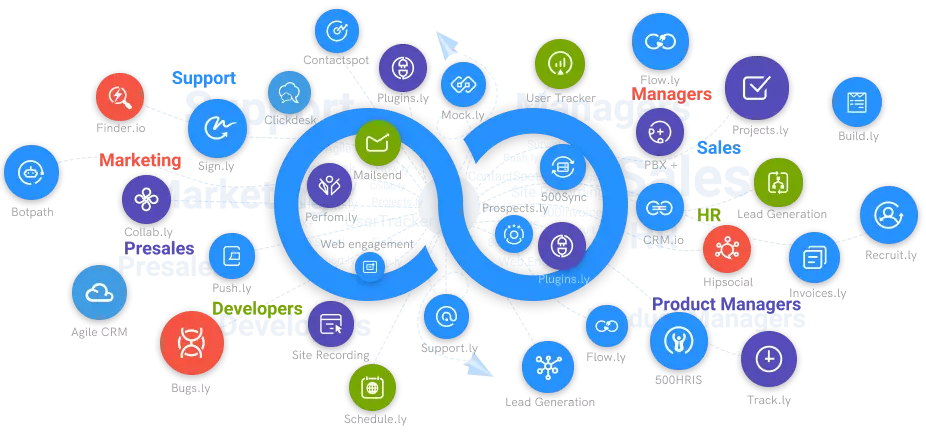What is the need for Data Integration?
Data integration is an essential service for every organisation that wants to manage, analyse, and process data. It aids in the gathering, storage, retrieval, and exchange of data.
#1
All-in-One Suite with more than 50 apps
#2
Everything you need today and in the future for all departments
#3
Unbelievable value - the lowest pricing you will ever find
#4
Hosted in 6 locations for compliance and blazing speeds
#5
24/5 Support - FREE chat, email and phone
#6
Uncapped features - limits you will never reach humanly
#7
Managed and maintained everyday by a dedicated team
#8
No downtime - comes with a 99.9% uptime guarantee
#9
Supports a number of international languages
#10
We've everything covered - 90k+ trust us with their business
Depending on the size of the organization, the objectives that must be achieved, and the available resources, there are several approaches for integrating data. Individual users can manually integrate data by gathering the relevant information from various sources, accessing the interface, cleaning the data as necessary, and combining it into a warehouse. The advantages of a data warehouse enable firms to do analysis utilizing the data stored in the warehouse. Important insights gleaned from this investigation may aid the company in making wiser decisions.
Simply said, using this approach enables businesses to combine data from many sources and systems and turn it into insightful and practical information. For instance, a business may combine information and data from its CRM system, customer-focused apps, automation software, and e-mail to generate a comprehensive picture of a targeted client base. Through CRM integration, businesses may combine their data to make it simpler to evaluate and switch between sources.

Data integration, in short, generates a unified picture of company data that business intelligence applications can access and gives actionable insights based on the full business data, independent of its original source format. Alongside, a workflow app automates the work that is done during a business process..
Integrate Data from Multiple Sources
Data integration is the process of merging data from many sources and systems to generate an unified collection of information for operational and analytical use. Data integration is a set of procedures that integrate data from many sources and store it in an enterprise data store so that marketing managers may execute data analysis and turn the data into useful information. This is a process that merges data from several sources into a single unified picture, making it actionable and valuable to the firm.
The most important goal of data integration is to create a clean and consistent data set that meets the needs of various end-users and organizations. Data integration helps companies collect relevant data from multiple sources and provides the user with a real-time view of business performance. Data integration is necessary to support business intelligence, enterprise reporting, and advanced analytics.
To be successful in today's business world, it is critical to extract the most value from your data. Converting data into meaningful information allows businesses to make better decisions and expand faster.
Integration procedures for big data volumes, for example, and multi-threaded jobs with many data sources need powerful data validation and exception management. When establishing data integration, it is critical to understand what sorts of data must be gathered and processed, where the data originates from, how the system will use the data, what types of analyses should be conducted, and which data reports must be updated.
Achieve Flexibility Using Data Transformations
Companies should be able to consolidate and streamline data access. Data processes and production-class scripts must automate the procedures necessary to process and transfer data while meeting a variety of operational constraints. Significant business logic and data transformations require developers logging steps and taking additional precautions to ensure observability of integrations.

People with integrated data have the freedom to use data from various internal systems as they see fit. By integrating data from numerous sources, marketing and sales teams acquire a full and organised view of consumers, their behaviour, touchpoints, and pain areas. Business intelligence tools that make use of extensive data integration information can extract valuable business insights from a company's past and present data.
How Does Data Integration Serve the Industries?
Real-time information transmission, data enrichment, and customer data analysis are all advantages of Data Integration for business intelligence. Cross-system collaboration improves an organization's total business intelligence, and data integration insights provide a better grasp of the information required to simplify corporate strategy and operations. It is easier for a company to identify and target its customers, as well as take advantage of value-added benefits such as updated records that reflect accurate customer information, managed databases for sales and leads, process tracking and monitoring, identifying future opportunities, and approaching partners and customers, with data integration.
As more of our interactions take place online, each stage of company operations creates data, and this data is valuable because it shows how each stage of the business can be streamlined, simplified, and made more efficient. As a result, businesses must integrate, combine, and utilise data to acquire the insights required to make sound business decisions.
The process of building a uniform system for data consulting and the input of corporate information from many sources is known as data integration. Workflow management software, cloud servers, and on-premises servers are all examples of this.
Streamline Business Processes
Data integration is the practice of combining data from many sources into a single dataset with the ultimate purpose of enabling consistent access and data delivery across a wide range of subjects, formats, and data kinds to suit the information needs of applications and business processes. Large corporations employ data integration to build data warehouses that merge many data sources into relational databases. With app integration software, it enables big data querying for corporate intelligence, customer data analysis, data enrichment, and real-time information distribution.
Consolidating data in a central repository enables organisations' teams to enhance performance metrics, obtain deeper insights and actionable knowledge, and make educated decisions to support corporate goals. The technological and business methods used to combine data from many sources and create a single view of it are referred to as data integration. Merging data collected across many platforms and integrating it into a data integration platform produces relevant information to help different companies in their team collaboration.
Conclusion
Data integration is essential for businesses today because it enables them to better utilise their data, better understand their consumers, and increase operational efficiency with the help of an app integration software like ZapUp by 500apps. Furthermore, data integration can assist businesses in avoiding the expenses associated with duplicating data and data silos.





